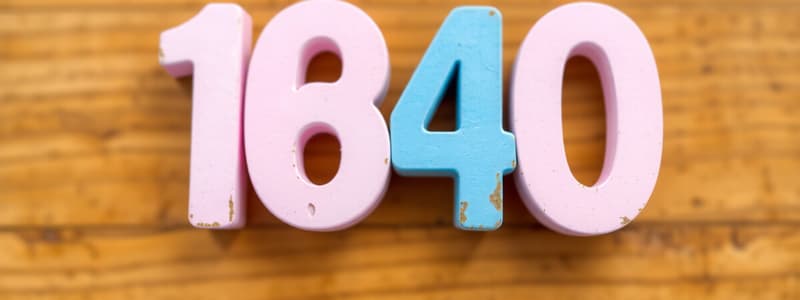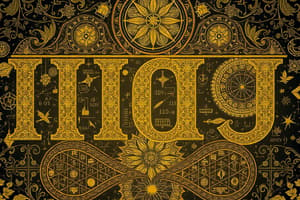Podcast
Questions and Answers
What is the primary purpose of rounding numbers in mathematical calculations?
What is the primary purpose of rounding numbers in mathematical calculations?
- To compare numbers accurately
- To find exact values for calculations
- To approximate values for ease of calculation (correct)
- To convert numbers into different representation systems
Which of the following best describes the importance of ordering and comparing numbers from 1 to 100,000?
Which of the following best describes the importance of ordering and comparing numbers from 1 to 100,000?
- It is mainly for aesthetic reasons in mathematics.
- It focuses solely on understanding prime numbers.
- It is irrelevant for basic arithmetic operations.
- It helps in solving various mathematical problems and sorting sets. (correct)
How can understanding patterns in sequences of numbers aid in calculations?
How can understanding patterns in sequences of numbers aid in calculations?
- It complicates the understanding of number arrangements.
- It provides shortcuts and deeper insights into mathematical concepts. (correct)
- It limits the ways in which calculations can be performed.
- It helps in memorizing large sets of numbers.
What role does proper knowledge of place value play in word formulation for numbers?
What role does proper knowledge of place value play in word formulation for numbers?
In which situation might one need to represent numbers in binary or hexadecimal systems?
In which situation might one need to represent numbers in binary or hexadecimal systems?
What is the smallest positive integer in the range from 1 to 100,000?
What is the smallest positive integer in the range from 1 to 100,000?
Which digit in the number 56,342 represents the thousands place?
Which digit in the number 56,342 represents the thousands place?
When counting from 1 to 100,000, which arithmetic concept is primarily illustrated?
When counting from 1 to 100,000, which arithmetic concept is primarily illustrated?
How does grouping numbers in sets of tens or hundreds benefit mathematics?
How does grouping numbers in sets of tens or hundreds benefit mathematics?
Which statement correctly describes even numbers?
Which statement correctly describes even numbers?
Which of the following is an example of a special number?
Which of the following is an example of a special number?
What basic arithmetic operation can be applied to the numbers from 1 to 100,000?
What basic arithmetic operation can be applied to the numbers from 1 to 100,000?
Which feature of the place value system allows representing large quantities with fewer symbols?
Which feature of the place value system allows representing large quantities with fewer symbols?
Flashcards
What are the numbers 1 to 100,000?
What are the numbers 1 to 100,000?
The numbers from 1 to 100,000 represent all positive integers in this range, including those used for counting and other mathematical operations.
What is place value?
What is place value?
Each position within a number has a specific value, such as "ones", "tens", "hundreds", etc. This system helps us understand the magnitude of each digit in a number.
How does counting work within numbers 1 to 100,000?
How does counting work within numbers 1 to 100,000?
Counting from 1 to 100,000 involves repeatedly adding 1 to the previous number. This process illustrates the fundamental concept of addition and counting.
What are the groupings of numbers within 1 to 100,000?
What are the groupings of numbers within 1 to 100,000?
Signup and view all the flashcards
How are numbers classified as even or odd?
How are numbers classified as even or odd?
Signup and view all the flashcards
What are some special numbers within 1 to 100,000?
What are some special numbers within 1 to 100,000?
Signup and view all the flashcards
How do arithmetic operations apply to numbers 1 to 100,000?
How do arithmetic operations apply to numbers 1 to 100,000?
Signup and view all the flashcards
Number Patterns
Number Patterns
Signup and view all the flashcards
Ordering Numbers
Ordering Numbers
Signup and view all the flashcards
Rounding Numbers
Rounding Numbers
Signup and view all the flashcards
Number Words
Number Words
Signup and view all the flashcards
Number Systems Beyond Decimal
Number Systems Beyond Decimal
Signup and view all the flashcards
Study Notes
Numbers 1 to 100,000
- Numbers from 1 to 100,000 are whole numbers.
- These numbers are sequentially ordered from 1 to 100,000.
- This set includes all positive integers in the range.
- Understanding these numbers is crucial for various mathematical fields.
Place Value
- Place value is pivotal to understanding the magnitude of these numbers.
- Each digit's position determines its place value (hundreds, thousands, etc.).
- This system efficiently represents large quantities using limited symbols.
Counting by Ones
- Counting from 1 to 100,000 involves adding one repeatedly.
- This illustrates the basic concept of addition.
- It connects to the ideas of cardinality and counting.
Grouping of Numbers
- Numbers group in sets of tens, hundreds, and thousands.
- These groupings define the decimal number system.
- Grouping improves the readability and comprehension of large numbers.
Even and Odd Numbers
- Numbers are classified as even (divisible by 2) or odd.
- Even numbers are divisible by two.
- Odd numbers are not divisible by two.
Special Numbers
- The range includes prime and perfect numbers.
- Understanding special numbers relates to advanced mathematical concepts.
- Further study is needed to explore these numbers fully.
Arithmetic Operations
- Arithmetic operations (addition, subtraction, multiplication, and division) apply to numbers 1 to 100,000.
- These operations are fundamental for problem-solving.
- These are crucial for daily and mathematical calculations.
Patterns
- Patterns exist in the sequence of numbers.
- Patterns in the arrangement of digits provide shortcuts for calculations.
- Patterns offer insights into the number system.
Ordering and Comparing
- Ordering numbers 1 to 100,000 is essential.
- Understanding the relative sizes of these numbers is critical for various tasks.
- Comparing numbers is often a prerequisite for other concepts.
Rounding
- Numbers can be rounded to tens, hundreds, thousands, etc.
- Rounding approximates values to a specific precision.
- This is useful for simplifying calculations and estimations.
Word Formulation
- Translating numbers into words accurately is important.
- This process relies on place value knowledge.
- This translates numerical values for clear communication.
Representation in Other Systems
- Other systems (binary, hexadecimal) can represent numbers in this range.
- These are crucial in computer science and digital systems.
Studying That Suits You
Use AI to generate personalized quizzes and flashcards to suit your learning preferences.





